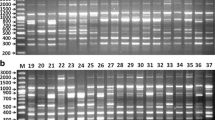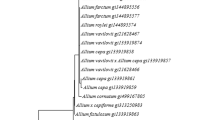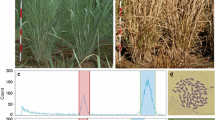Abstract
Repeat unit length variation and internal transcribed spacer (ITS) sequences of nuclear ribosomal DNA were used to assess genetic diversity, and phylogenetic relationships in chickpea (C. arietinum) cultivars, and its related wild species. Total genomic DNAs of 76 accessions of 10 Cicer species, belonging to three sections of the genus, were restricted with seven enzymes and the restriction fragments were hybridized to heterologous ribosomal clones of wheat pTa71 and Vicia faba probes Ver 6-5 and Ver18-6. A single repeat unit length class of 11.4 kb or 10.5 kb was recognized across Cicer accessions with pTa71. The intraspecific variation was negligible in those species where more than one accession was studied, except the four C. judaicum accessions, which were different from the rest. EcoRI and DraI digests gave two and one-two fragments, respectively. All the accessions produced three and three-five bands with BamHI and SacI, respectively. Both the accessions of C. yamashitae differed in their rDNA repeat unit length as well as restriction site variation. Maximum likelihood tree with rDNA RFLP recognized five clades which were more or less congruent with the previous data. Length of ITS-1 region was more variable (235–239 bp) than the ITS-2 region (212–213 bp). Cladistic analysis of ITS data revealed two major clades, clade I consisting of C. arietinum, C. reticulatum and C. echinospermum, and clade II comprised of C. judaicum, C. chorassanicum, C. bijugum and C. cuneatum. C. microphyllum grouped with the above four species. C. pinnatifidum was present as a separate branch. C. yamashitae emerged as the most distinct species.




Similar content being viewed by others
References
Ahmad F (1988) Interspecific hybridization and genetic relationships among annual Cicer species. Ph.D. thesis. University of Saskatchewan, Canada
Ahmad F (1999) Random amplified polymorphic DNA (RAPD) analysis reveals genetic relationships among the annual Cicer species. Theor Appl Genet 98:657–663
Ahmad F, Slinkard AE (1992) Genetic relationships in the genus Cicer L. as revealed by polyacrylamide gel electrophoresis of seed storage proteins. Theor Appl Genet 84:688–692
Ahmad F, Gaur PM, Slinkard AE (1992) Isozyme polymorphism and phylogenetic interpretations in the genus Cicer L. Theor Appl Genet 83:620–627
Ahmad F, Slinkard AE, Sedes GJ (1987) The cytogenetic relationship between Cicer judaicum Boiss. and Cicer chorassanicum (Bge) M. Pop. Genome 29:883–886
Appels R, Dovarak J (1982) The wheat ribosomal DNA spacer region : Its structure and variation in populations and among species. Theor Appl Genet 63:337–348
Baldwin BG, Sanderson MJ, Porter JM, Wojciechowski MF, Campbell CS, Donoghue MJ (1995) The ITS region of Nuclear Ribosomal DNA: a valuable source of evidence on Angiosperm Phylogeny. Ann Missouri Bot Gard 82:247–277
Bannerjee H, Pai RA, Sharma RP (1999) Restriction fragment length polymorphism and random amplified polymorphic DNA analysis of chickpea accessions. Biol Plant 42(2):197–208
Berger J, Abbo S, Turner NC (2003) Ecogeography of annual Wild Cicer Species: the poor state of the world collection. Crop Sci 43:1076–1090
Choumane W, Winter P, Wiegand F, Kahl G (2000) Conservation and variability of sequence tagged microsataellite sites (STMSs) from chickpea (Cicer arietinum L.) within the genus Cicer. Theor Apl Genet 101:269–278
Delgado-Salinas A, Turley T, Richman A, Lavin M (1999) Phylogenetic analysis of cultivated and wild species of Phaseolus (Fabaceae). Syst Bot 23:438–460
Favell RB, O’ Dell M, Sharp P, Nevo E, Beiles A (1986) Variation in the intergenic spacer of ribosomal DNA of wild wheat Triticum dicoccoides. Isrl Mol Biol Evol 3:547–558
Felsenstein J (1985) Confidence limits on phylogenies: an approach using the bootstrap. Evolution 39:783–791
Food and Agriculture Organization (FAO) of the United Nations (1994) Production Yearbook. Rome, Italy
Gerlach WL, Bedbrook JR (1979) Cloning and characterisation of ribosomal RNA genes from wheat and barley. Nucl Acid Res 7:1869–1885
Goel S, Raina SN, Ogihara Y (2002) Molecular evolution and phylogenetic implications of internal transcribed spacer sequences of nuclear ribosomal DNA in the Phaseolus-Vigna complex. Mol Phylo Evol 22:1–19
Iruela M, Rubio J, Cubero JI, Gil J, Milan T (2002) Phylogenetic analysis in the genus Cicer and cultivated chickpea using RAPD and ISSR markers. Theor Appl Genet 104:643–651
Iyengar NK (1939) Cytological investigations on the genus Cicer. Ann Bot 3:272–306
Javadi F, Yamaguchi H (2004a) RAPD and seed coat morphology variation in annual and perennial species of the genus Cicer L. Genet Resour Crop Evol 51:783–794
Javadi F, Yamaguchi H (2004b) Interspecific relationships of the genus Cicer L. (Fabaceae) based on trnT-F sequences. Theor Appl Genet 109:317–322
Kazan K, Muehlbauer FJ (1991) Allozyme variation and phylogeny in annual species of Cicer (Leguminosae). Plant Syst Evol 175:11–21
Kupicha FK (1976) The infrageneric structure of vicia. Notes R Bot Gard. Edinburgh 34:287–326
Kupicha FK (1981) Cicerae Alefeld. In: Pollhill R, Raven P (eds) Advances in Legume systematics, part 1. Royal Botanic Gardens, Kew, England, p 382
Kutekar DR, Wanjari KB (1983) Karyomorphological studies in some of the varieties of Bengal gram (Cicer arietinum Linn). Cytologia 48:699–705
Labdi M, Robertson LD, Singh KB, Charrier A (1996) Genetic diversity and phylogenetic relationships among annual Cicer species as revealed by isozyme polymorphism. Euphytica 88:181–188
Ladizinsky G, Adler A (1975) The origin of chickpea as indicated by seed protein electrophoresis. Isrl J of Bot 24:183–189
Ladizinsky G, Adler A (1976a) Genetic relationships among the annual species of Cicer L. Theor Appl Genet 48:197–203
Ladizinsky G, Adler A (1976b) The origin of chickpea, Cicer arietinum L. Euphytica 25:211–217
McMullen MD, Hunter B, Philips LR, Rubenstein I (1986) The structure of the maize ribosomal DNA pacer. Nucl Acids Res 14:4953–4968
Muehlbauer FJ, Singh KB (1987) Genetics of chickpea. In: Saxena MC, Singh KB (eds) The chickpea. CAB Int Publ, UK pp 99–126
Nguyen TT, Taylor PWJ, Redden RJ, Ford R (2004) Genetic diversity estimates in Cicer using AFLP analysis. Plant Breed 123:173–179
Ocampo B, Venora G, Errico A, Singh KB, Saccardo F (1992) Karyotype analysis in the genus Cicer. J Genet Breed 46:229–240
Ohri D, Pal M (1991) The origin of chickpea (Cicer arietinum L.): karyotype and nuclear DNA amount. Heredity 66:367–372
Patil PB, Vrinten PL, Scoles GJ, Slinkard AE (1995) Variation in the ribosomal RNA units of the genera Lens and Cicer. Euphytica 83:33–42
Raina SN, Ogihara Y (1995) Ribosomal DNA repeat unit polymorphism in 49 Vicia species. Theor Appl Genet 90:477–486
Reed KC, Mann DA (1985) Rapid transfer of DNA from agarose gels to nylon membranes. Nucl Acids Res 3:7207–7221
Robertson LD, Ocampo B, Singh KB (1997) Morphological variation in wild annual Cicer species in comparison to the cultigen. Euphytica 95:309–319
Rogers SO, Honda S, Bendich AJ (1986) Variation in the ribosomal RNA genes among individuals of Vicia faba. Plant Mol Biol 6:339–345
Rogers SO, Bendich AJ (1987) Ribosomal RNA genes in plants: variability in copy number and in intergenic spacer. Plant Mol Biol 9:509–520
Sanderson MJ, Wojciechowski MG (1996) Diversification rates in a temperate legume clade. Are there so many species of Astragalus (Fabaceae)? Amer J Bot 83:1488–1502
Singh KB (1997) Chickpea (Cicer arietinum L.). Field Crop Res 53:161–170
Singh KB, Ocampo B (1993) Interspecific hybridization in annual Cicer species. J Genet Breed 47:199–204
Singh KP, Singh A, Raina SN, Singh AK, Ogihara Y (2002) Ribosomal DNA repeat unit polymorphism and heritability in peanut (Arachis hypogaea L.) accessions and related wild species. Euphytica 123:211–220
Staginnus C, Winter P, Desel C, Schmidt T, Kahl G (1999) Molecular structure and chromosomal localization of major repetitive DNA families in the chickpea (Cicer arietinum L.) genome. Plant Mol Biol 39:1037–1050
Sudupak MA, Akkaya MS, Kence A (2002) Analysis of genetic relationships among perennial and annual Cicer species growing in Turkey using RAPD markers. Theor Appl Genet 105:1220–1228
Sudupak MA, Akkaya MS, Kence A (2004) Genetic relationships among perennial and annual Cicer species growing in Turkey assessed by AFLP fingerprinting. Theor Appl Genet 108:937–944
Sue Porebski L, Grant B, Bernard R, Baum (1997) Modification of a CTAB DNA extraction protocol for plants containing high polysaccharide and polyphenol components. Plt Mol Biol Rep 15(1):8–15
Swofford D (1998) PAUP* Phylogenetic Analysis Using Parsimony (*and other methods). Version 4. Sinauer Associates, Sunder land, Massachuselts. Ten flourochromes J Histochem Cytochem 40:1789–1797
Tayyar RI, Lukaszewski AJ, Waines JG 1994. Chromosome banding patterns in the annual species of Cicer. Genome 37:656–663
Tayyar RI, Waines JE (1996) Genetic relationships among annual species of Cicer (Fabaceae) using isozyme variation. Theor Appl Genet 92:245–254
Thompson JD, Gibson TJ, Plewniak F, Mongin FJ, Higgins DG (1997) Clustal X Windows interface: flexible strategies for multiple sequence alignment aided by quality analysis tools. Nucl Acids Res 25(24):4876–4882
Udupa SM, Sharma A, Sharma RP, Pai RA (1993) Narrow genetic Variability in Cicer arietinum L. as revealed by RFLP Analysis. J Plt Biochem Biotech 2:83–86
Vairinhos F, Murray DR (1983) The seed proteins of chickpea: comparative studies of Cicer arietinum, C. reticulatum and C. echinospermum (Leguminosac). Pl Syst Evol 142:11–22
Van der Maesen LJG (1972) Cicer L. A monograph of the genus, with special reference to the chickpea (Cicer arietinum L.), its ecology and cultivation. Meded Landbouwhogeschool, Wageningen 72–10 p 342
Van der Maesen LJG (1987) Origin, history and taxonomy of chickpea. In: Saxena MC, Singh KB (eds) The chickpea. CAB Int Publ, UK pp 11–34
Van Rheenen HA (1992) Biotechnology and chickpea breeding. Intl Chickpea Newsletter 26:14–17
White TJ, Bruns T, Lee S, Taylor J (1990) Amplification and direct sequencing of fungal ribosomal RNA genes for phylogenetics. In: Innis MA, Gelfand DH, Sninsky JJ, White TJ (eds) PCR protocols: a guide to methods and applications. Academic Press, San Diego pp 315–322
Wojciechowski MF, Sanderson MJ, Baldwin BG, Donoghue MJ (1993) Monophyly of aneuploid Astragalus (Fabaceae) evidence from nuclear ribosomal DNA internal transcribed spacer sequences. Am J Bot 80:711–722
Yakura K, Kato A, Tanifuji S (1984) Length and heterogeneity of the large spacer of Vicia faba rDNA is due to the differing number of a 326 bp repetitive sequence element. Mol Gen Genet 193:400–405
Acknowledgements
Grants received from Department of Science and Technology (DST), India are gratefully acknowledged. Apekshita Singh acknowledges the Research Fellowship grant from CSIR, India.
Author information
Authors and Affiliations
Corresponding author
Rights and permissions
About this article
Cite this article
Singh, A., Devarumath, R.M., RamaRao, S. et al. Assessment of genetic diversity, and phylogenetic relationships based on ribosomal DNA repeat unit length variation and Internal Transcribed Spacer (ITS) sequences in chickpea (Cicer arietinum) cultivars and its wild species. Genet Resour Crop Evol 55, 65–79 (2008). https://doi.org/10.1007/s10722-007-9215-8
Received:
Accepted:
Published:
Issue Date:
DOI: https://doi.org/10.1007/s10722-007-9215-8




